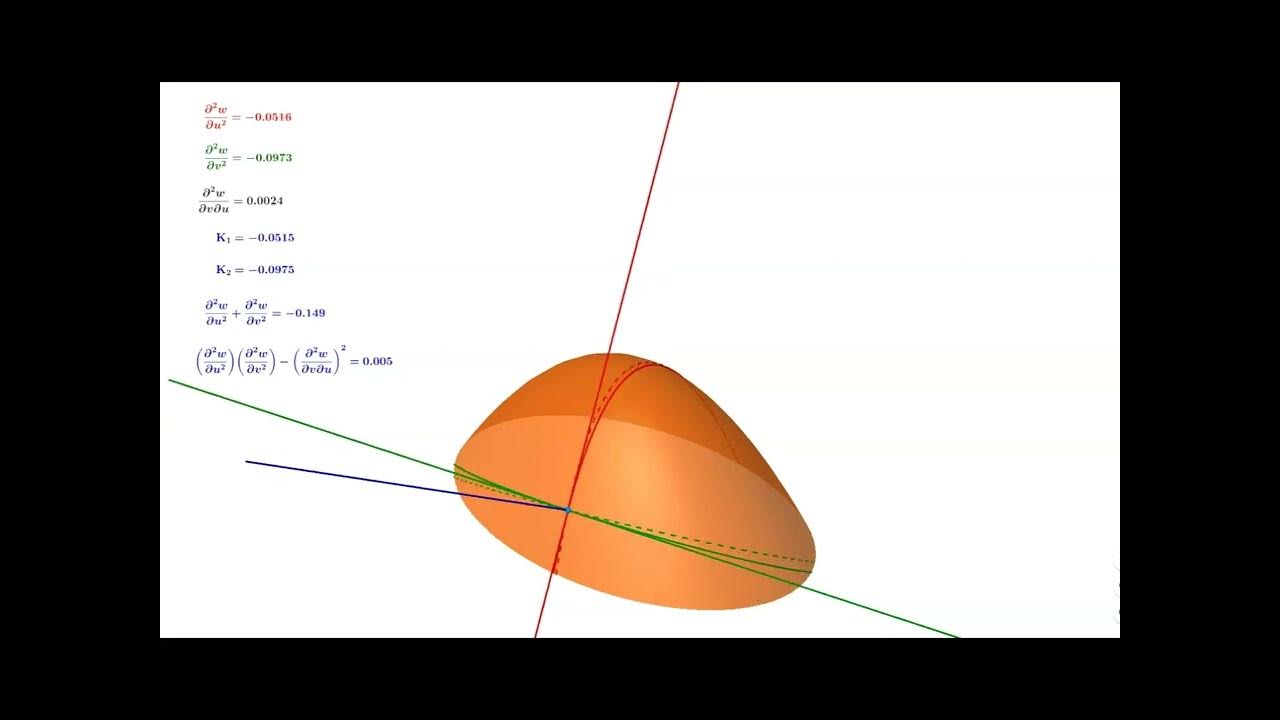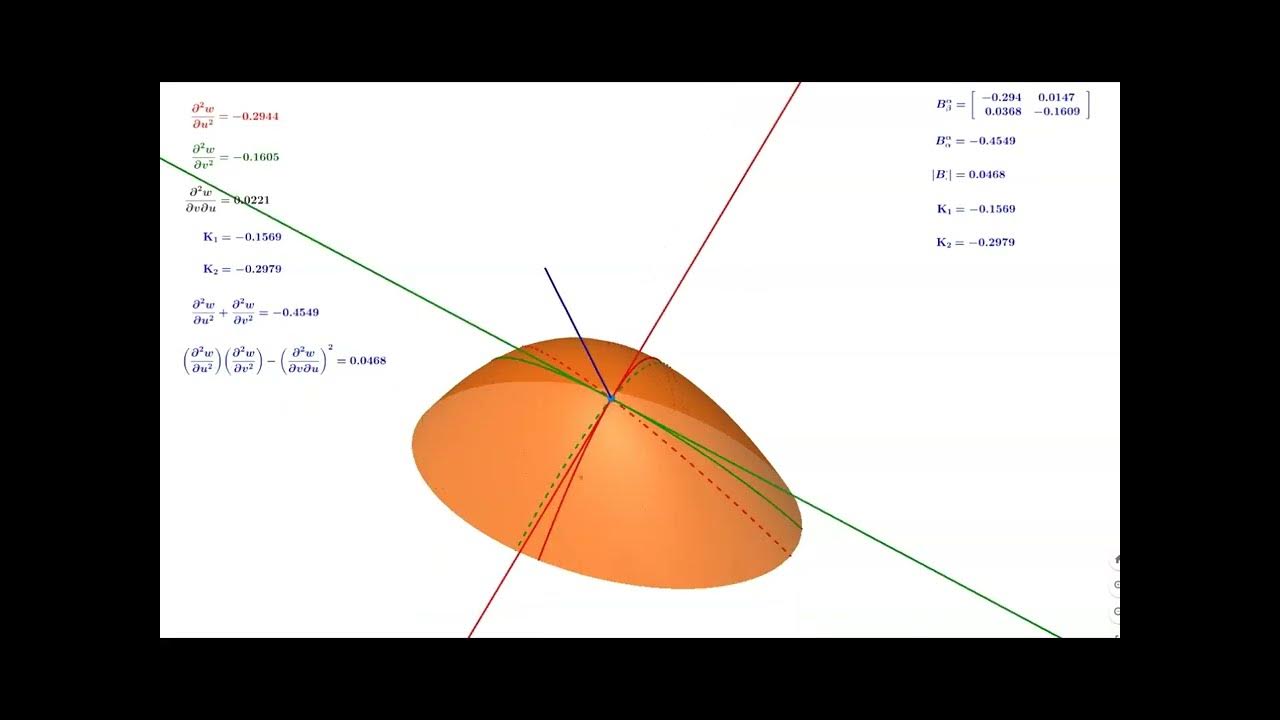Tensor Calculus Lecture 14f: Principal Curvatures
TLDRIn this final video of the series, the concept of principal curvature is introduced through a visual approach with minimal writing. The video focuses on the relationship between mean curvatures and curvature tensors, explaining how to derive the normal component of a surface equation. It delves into the geometric construction of principal curvatures by slicing the surface with planes containing the normal, leading to the definition of principal curvatures as the largest and smallest curvatures within these planes. The video connects these concepts to mean and Gaussian curvatures, utilizing linear algebra to frame the problem of finding principal curvatures as an eigenvalue optimization problem.
Takeaways
- 📚 The video discusses the concept of principal curvatures, a fundamental aspect of differential geometry.
- 🔍 The presenter introduces the relationship between mean curvatures and the normal component of a surface equation.
- 📐 The video focuses on visual explanations with minimal writing, emphasizing geometric thinking and visualization.
- 📈 The principal curvatures are defined as the maximum and minimum curvatures obtained from slicing the surface with planes containing the normal.
- 📉 The mean curvature of a surface is related to the sum of the principal curvatures, which is a key concept in the video.
- 📝 The script explains how to derive the principal curvatures using linear algebra and quadratic form optimization.
- 🧠 The presenter uses the dot product to isolate the normal component of the curvature tensor, simplifying the mathematical expression.
- 📊 The video connects the concept of principal curvatures to the curvature of curves embedded in planes, highlighting the Euclidean geometry aspect.
- 🔑 The eigenvalues of the curvature matrix are identified as the principal curvatures, Kappa 1 and Kappa 2.
- 🌐 Gaussian curvature, a measure for two-dimensional surfaces in three-dimensional spaces, is the product of the principal curvatures.
- 🔄 The video script emphasizes the historical and dimensional aspects of mean curvature, discussing its definition and evolution in mathematical literature.
Q & A
What is the main focus of the video?
-The main focus of the video is to introduce and explain the concept of principal curvatures in the context of differential geometry, using visual aids and minimal writing.
What is the relationship between mean curvatures and the normal component of a surface?
-The mean curvature of a surface can be derived by taking the normal component of the surface's curvature tensor equation, which involves dotting both sides with the normal vector to the surface.
How does the video explain the extraction of the normal component from an equation?
-The video explains that the normal component is extracted by multiplying both sides of the equation by the normal vector, which eliminates terms tangential to the surface and isolates the normal component.
What is the significance of the planes that contain the normal to the surface?
-These planes are significant because they are used to create cross-sections of the surface at a point of interest, allowing for the analysis of curvature in different directions relative to the normal.
What are the principal curvatures and how are they defined?
-Principal curvatures are the largest and smallest curvatures of a surface at a given point, defined as the eigenvalues of the curvature tensor matrix when the surface is sliced by planes containing the normal.
Why is it important to consider the mean curvature and Gaussian curvature in differential geometry?
-Mean curvature and Gaussian curvature are important because they are intrinsic properties of a surface that describe its shape and curvature characteristics, and they are invariants under isometries.
What is the connection between the eigenvalues of the curvature tensor matrix and the principal curvatures?
-The eigenvalues of the curvature tensor matrix correspond to the principal curvatures, with the largest eigenvalue representing the largest curvature and the smallest eigenvalue representing the smallest curvature.
How does the video relate the concept of principal curvatures to mean curvature?
-The video explains that the mean curvature is the sum of the principal curvatures, which is also the trace of the curvature tensor matrix.
What is the role of linear algebra in the discussion of principal curvatures?
-Linear algebra is used to formulate the problem of finding principal curvatures as a quadratic form optimization problem, where the eigenvalues of certain matrices represent the principal curvatures.
How does the video connect the concepts of principal curvatures to Gaussian curvature?
-The video connects the concepts by stating that Gaussian curvature, for two-dimensional surfaces embedded in three-dimensional spaces, is the product of the principal curvatures, which is also the determinant of the curvature tensor matrix.
What is the historical context of the term 'mean curvature' as discussed in the video?
-The term 'mean curvature' historically refers to the sum of the principal curvatures, sometimes divided by 2, depending on the dimensionality of the problem. However, the modern definition simply uses the sum without division.
Outlines
📚 Introduction to Principal Curvature
The speaker introduces the concept of principal curvature in the final video of a series. They emphasize the visual nature of the topic, with a focus on explaining rather than writing. The discussion begins with a relationship derived in a previous video, which connects mean curvatures and involves taking the normal component of an equation. The speaker then presents a new relationship that links the mean curvature of a surface to the curvature tensor, which is represented by normals. The visual aid includes a surface with two cross-sections, illustrating the geometric thinking behind principal curvatures.
🔍 Exploring Mean Curvature and Principal Normals
The speaker delves into the mean curvature of a curve embedded in a plane, which is determined by the normal to the overall surface. They pose the question of finding the largest and smallest values of curvature, which leads to the concept of principal normals. The discussion shifts to the idea of slicing planes that contain the normal to the surface, and how these planes affect the curvature. The speaker introduces the notion of eigenvalues in the context of quadratic form minimization, hinting at the connection between the curvature of the slicing plane and the principal curvatures, denoted as Kappa 1 and Kappa 2.
📐 Defining Principal Curvatures and Eigenvalues
The speaker redefines principal curvatures as the eigenvalues of a specific matrix, which is derived from the curvature tensor with raised indices. They clarify that these eigenvalues correspond to the smallest and largest curvatures attainable in the context of slicing planes. The speaker corrects a previous statement, emphasizing that the eigenvalues of two related matrices are the same, but their corresponding eigenvectors may differ. The connection between mean curvature, Gaussian curvature, and the eigenvalues of the curvature tensor is established, providing a deeper understanding of these concepts in the context of differential geometry.
🌐 Connecting Principal Curvatures to Mean and Gaussian Curvatures
In the concluding part, the speaker connects the concepts of principal curvatures to mean and Gaussian curvatures. They explain that mean curvature is the sum of the principal curvatures and that Gaussian curvature is the product of these curvatures, as per Gauss's theorema egregium. The speaker also touches upon the historical naming of mean curvature and its generalization to higher dimensions. The video ends with a reflection on the journey from considering double embeddings of curves and surfaces to the principles of curvature, encouraging further exploration of these concepts in differential geometry.
Mindmap
Keywords
💡Principal Curvature
💡Mean Curvature
💡Gaussian Curvature
💡Curvature Tensor
💡Eigenvalues
💡Normal Vector
💡Hypersurface
💡Quadratic Form
💡Linear Algebra
💡Differential Geometry
Highlights
Introduction to the concept of principal curvature in the final video of the series.
Explanation of the relationship derived in the last video that relates mean curvatures.
Demonstration of extracting the normal component from an equation by dotting both sides with the normal.
Discussion on the mean curvature of a surface embedded in space and its relation to curvature tensors.
Visual explanation of cross-sections between a curve and planes at a point of interest.
Description of the geometric construction involving slicing the surface with planes containing the normal.
Introduction of the concept of principal normals and their significance in curvature.
Exploration of the largest and smallest curvature values obtainable from different slicing planes.
Transition from geometric concepts to linear algebra in the discussion of curvature.
Introduction of the quadratic form optimization problem related to curvature.
Definition of principal curvatures (Kappa 1 and Kappa 2) as eigenvalues of a specific matrix.
Connection between the eigenvalues of the matrix and the largest and smallest curvatures.
Explanation of mean curvature as the sum of principal curvatures.
Discussion on Gaussian curvature and its relation to the product of principal curvatures.
Clarification on the historical naming and definition of mean curvature.
Generalization of the concepts of mean and Gaussian curvature to higher dimensions.
Conclusion summarizing the journey from double embeddings to principal curvature concepts.
Transcripts
Browse More Related Video

Video 78 - Gaussian Curvature

Video 80 - Curvature Tensor - Part 2

Tensor Calculus Lecture 14a: Non-hypersurfaces

Tensor Calculus Lecture 14d: Non-hypersurfaces - Relationship Among Curvature Tensors 1

Tensor Calculus Lecture 14c: Non-hypersurfaces - Relationship Among The Shift Tensors

Tensor Calculus Lecture 15: Geodesic Curvature Preview
5.0 / 5 (0 votes)
Thanks for rating: